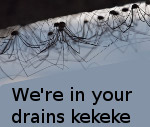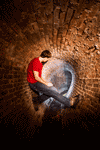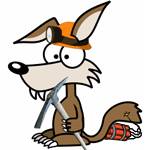I wrote this for elsewhere, but it's relevant.
My photostream is cut short because I let my Pro account expire. Thinking about re-upping that because all my experimentation in lightpainting is hidden now.
flickr clickrHere's some pictures of interest; mostly by other people. Lightpainting is kind of a performance art in that all the lighting done is compressed into one frame. Check out this site for ideas to practice. You shoot digital, so you can play around with things.
LongExposure.net Steel wool spinning, Ashes in the Snow
Road flare pose. Adding a bit of white light helps focus, due to optics monochrome focus is touchy, Ashes in the Snow
Colored LEDs, blue and red, Aurelie
Steel wool and sparklers with tea lights, Aurelie
A bit of the rainbowgun. It really does cast stripes in long exposure. , my photo
Rainbowgun explained. Sharpie on clear packing tape on a spotlight., my photo
Fire and HID spotlight (color temperature difference, 8000K vs. 4000K, causes the blueness), my photo
Maybe when I pay Flickr's fee I can post the better ones.
These photos are all about: Moving light and Balancing light. In the last picture, I had the spotlight on for about 1.5 seconds of a 5 second exposure. Concealing light. An invisible light source casts the best shadows.
Steel wool spinning: Don't do this around flammable things. You'll throw molten steel around and may want a hat to protect your hair. It hurts bare skin but hasn't left marks on me yet. Buy #0000 steel wool (near painting and sanding stuff), and clip a chunk of it into a cheap keychain carabiner. Tie a rope to this and spin it. Okay, now light the steel wool on fire. A lighter works, so does a 9v battery; just get some of the wool glowing and spin. The forced air will make more burn. The steel wool costs about $4 per pack of 12 little rolls, I use 1 or 2 per shot. If you soak the steel wool in flammable liquid then you'll have a ring of intense fire throwing molten sparks around.
Rainbowgun: That spotlight is the Black & Decker V-2million, a decent halogen spotlight. It's limited by the SLA battery, but those are cheap. About $30 at home depot. Put packing tape over the front of the light and color a pattern with sharpies. I used horizontal lines, and did 2 layers colored. Cover the last color layer with one more of clear tape to protect your custom gel. If you go to a camera store you can sometimes get a "Gel sample pack" of purer colors. Cutting and taping these together is another way to make colors. It's easy to make any bright light look neat with these, but dimmer ones are wasted since you lose so much power by filtering colors.
Sparklers: Just wave them around. Works best around water for the reflection. You'll have to move them very quickly or they overexpose because the burning stuff (magnesium?) is intensely bright. If they overexpose then it will just appear to be a white blaze, which is okay. It's easy to spin them at arm's length, but try running with them. Running down a tunnel or hallway on a high f/stop looks pretty cool; especially with a wet floor to reflect it.
Road flares. If you want to use them all the way to the end, lash the flare to a handle with metal wire. Note that this will soon be a metal handle very close to burning metal in the flare, but it lets you avoid dripping stuff. I melted a tripod that was holding the flare by forgetting to do this once. The pure red is a pain; I suggest mixing in a bit of white light for focus and general not-looking-funny. Only takes a bit of white light. Mind the slag.
Tea lights. Cheap ones suck. If you have still air you can use 'em. They don't cast much light and basically look like intense points of light, but if they're just out of sight they look neat. If you light a bunch on a board, then submerge that board, you can get good flame trails on water. They are a huge pain to deal with, but can look neat. Try putting them in little plastic clear cups as diffusers, the cups can also be taped or glued to walls. Do clean up after yourself.
General lighting. LEDs are nice, but normal LEDs mostly emit blue and yellow photons, with very few green or red photons. Browns, reds (skin tones), and greens suffer; and you can kinda bring that back with editing. But Neutral White LEDs are closer to 'right,' and high CRI LEDs are amazing but expensive. You lose a bit of output, but not enough to really notice. Spotlights work well and don't have spectral issues, although HID ones are often sold at depressingly high color temperatures; Mine claims 8000K and I can believe it.
Fire. Fire will make all other light sources look cold in a photo. I've had direct sunlight look like glacier blue ice because of fire's color temperature; it's all about your choices. Charcoal starter fluid requires a wick (paper works) to burn unless you have the liquid hot enough to vaporize very quickly. Alcohols burn blue, but it's very dim. In theory you can mix salts in to color a flame, and that's easier with a blue flame. Other flammable liquids tend to burn yellow. I like lamp oil currently, although it also requires a wick. Be sure to use containers that won't shatter and send fire everywhere, and again don't use fire around burnable things besides you. There is also no good excuse for carrying a quart of lamp oil and lighters if you're in places you shouldn't be.
Lighting techniques: The lights should draw out the form of what you're shooting. For a portrait, you want to reduce shadows on the face. For art photography, the shadows and texture should be emphasized. This means you'll move the light until you have crisp shadows on many surfaces; like a flashlight right at the base of a brick wall. Balance the light in a scene. Suppose you have a very bright light and want some street light to be visible; you'll have a long exposure with the bright light on for only part of the exposure time. It's a cross between a flashgun and lightpainting. How long to do it for different light levels is a matter of feel and knowing your lighting.
Lens: You'll often want a higher f/stop in these shots, around f/5 or f/8 to have a broad area in focus. It hurts to have everything right but all the should-be-sharp sparks out of focus. Wide lenses help if you're shooting in a small space, but notice chromatic aberration. It's a fact in most cheap glass, so try to keep the most dramatic contrast in the center of the lens. I suggest pulling off the protective UV filter while painting, once you have the tripod secure. If you don't have such a thing, get one - lens scratches are pretty expensive. Better lenses are always nice, but you get what you get.
Tripod: You probably need one. Lightpainting is made of long exposures. You will hate yourself for not having one. Maybe you can be clever with friendly rocks, but a tripod is worth it. Get one that'll hold the camera steady. The mirror moving will shake a light tripod, but you can get a sturdy used one. You can make your own tripod shoe; carve a plywood plate to fit in the holder and put a short quarter twenty (1/4", 20 turns per inch) bolt through it.
Shooting. A wire trigger is nice, because bulb mode gives you minutes to do the lightpainting. For Canon it's easy to hack together a trigger, but I think it's harder for Nikon. This reduces the shaking when you hit the shutter, giving more control over what's moving. You can often get these for cheap. I use a magnet on mine to keep the button held down, another photographer here built one with a rocker switch. You're unlikely to need a high ISO since fire is really bright. If you can't manage a wire trigger, a delay shoot helps. Also that gives you a bit of time to get to where you're shooting. If you are shooting shorter frames, I suggest using a multishot rather than bulb mode. With my camera I can get (10s delay) + (10 x exposure time). If I'm only doing 30s of steel wool spinning I can easily climb up to where I'm going to work while my camera wastes frames. Digital shots are nearly free, take advantage of that. Since you're cueing all the action, it's easier than normal to take time to wire trigger or delay it all.
Chimping. Look at the pictures you're getting. Zoom in, use the Histogram View if you have one, see what's overexposed. Long exposures are tricky to get right until you have a feel for it, and anyone can goof on framing or lighting. In normal photography a properly exposed shot will look pretty much like it does to the eye, but here you're freezing minutes of work - make sure you did it right before you pack up.
Editing. Shoot raw. Edit raw for curves and color balance. Once you're comfortable with it, you'll kick yourself for not starting sooner. I use UFRAW and GIMP (Linux user); but I have ideological differences and wouldn't use Adobe stuff at any price. CS3 and Adobe Raw are popular choices and you know where those can be had at a nice price. The color temperature slider and the better curve control are the biggest benefits in RAW, but some other benefits are good. You'll want these things more than normal photography because it's common to use mixed lighting and that usually leads to exposure and CCT challenges.
I think that covers most of how lightpainting is different from normal photography.

 order your copy of Access All Areas today!
order your copy of Access All Areas today!








